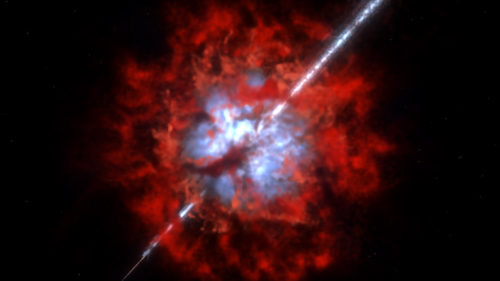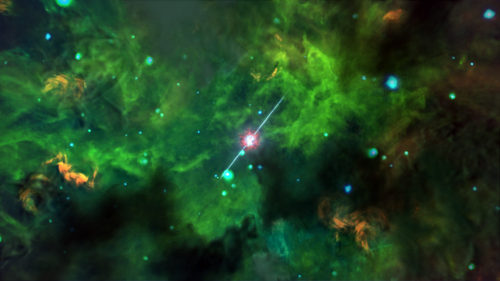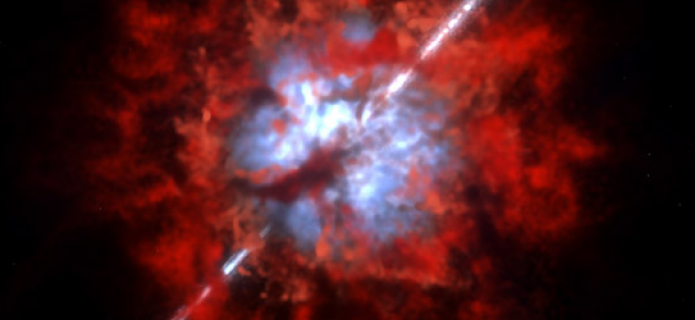Gigantic Explosions Buried in Dust: ALMA Probes Environment around Gamma Ray Bursts
11 June, 2014 / Read time: 7 minutes
Japanese observations from the Atacama Large Millimeter/submillimeter Array (ALMA) have for the first time directly mapped out the molecular gas and dust in the host galaxies of gamma-ray bursts (GRBs) — the biggest explosions in the Universe. In a complete surprise, less gas was observed than expected, and correspondingly much more dust, making some GRBs appear as “dark GRBs”. This work will appear in the journal Nature on 12 June 2014 and is the first ALMA science result on GRBs to appear. It shows ALMA’s potential to help us to better understand these objects.
ALMA Probes Gamma Ray Bursts from NRAO Outreach on Vimeo.
An artist’s conception of the environment around GRB 020819B based on ALMA observations. The GRB occurred in an arm of a galaxy in the constellation of Pisces (The Fishes). GRBs are huge explosions of a star spouting high-speed jets in a direction toward the observer. In a complete surprise, less gas was observed than expected, and correspondingly much more dust, making some GRBs appear as “dark GRBs”. Credit: NAOJ
Gamma-ray bursts (GRBs) are intense bursts of extremely high energy observed in distant galaxies — the brightest explosive phenomenon in the Universe. Bursts that last more than a couple of seconds are known as long-duration gamma-ray bursts (LGRBs) [1] and are associated with supernova explosions — powerful detonations at the ends of the lives of massive stars.
In just a matter of seconds, a typical burst releases as much energy as the Sun will in its entire ten-billion-year lifetime. The explosion itself is often followed by a slowly fading emission, known as an afterglow, which is thought to be created by collisions between the ejected material and the surrounding gas.

Fig. 1: An artist’s conception of the environment around GRB 020819B based on ALMA observations. Credit: NAOJ
However, some gamma-ray bursts mysteriously seem to have no afterglow — they are referred to as dark bursts. One possible explanation is that clouds of dust absorb the afterglow radiation.
In recent years, scientists have been working to better understand how GRBs form by probing their host galaxies. Astronomers expected that the massive stars that were GRB progenitors would be found in active star-forming regions in these galaxies, which would be surrounded by a large amount of molecular gas — the fuel for star formation. However, there had been no observational result to back up this theory, leaving a long-standing mystery.
A Japanese research group led by Bunyo Hatsukade, an assistant professor at the Chile Observatory of the National Astronomical Observatory of Japan (NAOJ), conducted observations of two galaxies hosting GRB 020819B and GRB 051022 whose distance from us is about 4.3 billion and 6.9 billion light years, respectively. Detection of radio emission from GRB host galaxies, which had been a long-sought goal for astronomers, was finally made possible by ALMA with its unprecedentedly high sensitivity [2].

Fig. 2: Observations of the host galaxy for GRB 020819B. Radio measurements of molecular gas (left) and dust (middle), both of which are observed with ALMA. An image in visible-light captured by the Frederick C. Gillett Gemini North Telescope (right). The cross indicates the location of the GRB site. Credit: Bunyo Hatsukade(NAOJ), ALMA (ESO/NAOJ/NRAO)
Kotaro Kohno, a professor at the University of Tokyo and a member of the research team, says, "We have been searching for molecular gas in GRB host galaxies over 10 years since 2003 using various telescopes around the world. As a result of our hard effort, we finally achieved a remarkable breakthrough using ALMA with unprecedentedly high sensitivity. We are very excited with what we have achieved." The sensitivity of ALMA in this observation was about five times better than the other telescopes ever used for the previous researches, although the observation time taken was just 47 minutes and the number of antennas used was only 27 (less than a half of the total number of antennas). The observation results demonstrated ALMA’s revolutionary capability even under limited conditions.
Another remarkable achievement made possible by the high resolution of ALMA was uncovering the distribution of molecular gas and dust in GRB host galaxies. Observations of the GRB 020819B revealed a remarkably dust-rich environment in the outskirts of the host galaxy, whereas molecular gas was found only around its centre. This is the first time that such a distribution among GRB host galaxies has been revealed [3].
"The results obtained this time were beyond our expectations. We need to carry out further observations with other GRB hosts to see if this could be general environmental conditions of a GRB site. We are looking forward to future researches with improved capability of ALMA" says Hatsukade.

Fig. 3: An artist’s conception of the environment around GRB 020819B based on observations with ALMA. Credit: NAOJ
Notes
[1] Long-duration gamma-ray bursts (LGRBs), bursts lasting for over two seconds, account for about 70% of observed GRBs. Developments over the past decade have recognized a new class of GRBs with bursts of less than two seconds, the short-duration GRBs, likely due to merging neutron stars and not associated with supernovae or hypernovae.
[2] The sensitivity of ALMA in this observation was about five times better than other similar telescopes. Early scientific observations with ALMA began with a partial array in 2011. These observations were done with an array only consisting of 24–27 antennas with separations of up to only 125 meters. The completion of the last of the 66 antennas offers great promise of what ALMA may be capable of revealing in the near future, as the antennas can be arranged in different configurations, with maximum distances between antennas varying from 150 meters to 16 kilometers.
[3] The proportion of dust mass to molecular gas mass is about 1% in the interstellar medium in the Milky Way and nearby star-forming galaxies, but it is ten or more times higher in the region surrounding GRB 020819B.
More Information
This research will be presented in a paper in Nature (12 June 2014) as an article titled “Two gamma-ray bursts from dusty regions with little molecular gas”, by B. Hatsukade et al.
The team is composed of B. Hatsukade (NAOJ, Tokyo, Japan), K. Ohta (Department of Astronomy, Kyoto University, Kyoto, Japan), A. Endo (Kavli Institute of NanoScience, TU Delft, The Netherlands), K. Nakanishi (NAOJ; JAO, Santiago, Chile; The Graduate University for Advanced Studies (Sokendai), Tokyo, Japan), Y. Tamura (Institute of Astronomy [IoA], University of Tokyo, Japan ), T. Hashimoto (NAOJ) and K. Kohno (IoA; Research Centre for the Early Universe, University of Tokyo, Japan).
The Atacama Large Millimeter/submillimeter Array (ALMA), an international astronomy facility, is a partnership of the European Organisation for Astronomical Research in the Southern Hemisphere (ESO), the U.S. National Science Foundation (NSF) and the National Institutes of Natural Sciences (NINS) of Japan in cooperation with the Republic of Chile. ALMA is funded by ESO on behalf of its Member States, by NSF in cooperation with the National Research Council of Canada (NRC) and the Ministry of Science and Technology (MOST) in Taiwan and by NINS in cooperation with the Academia Sinica (AS) in Taiwan and the Korea Astronomy and Space Science Institute (KASI).
ALMA construction and operations are led by ESO on behalf of its Member States; by the National Radio Astronomy Observatory (NRAO), managed by Associated Universities, Inc. (AUI), on behalf of North America; and by the National Astronomical Observatory of Japan (NAOJ) on behalf of East Asia. The Joint ALMA Observatory (JAO) provides the unified leadership and management of the construction, commissioning and operation of ALMA.
Contact:
Bunyo Hatsukade
Assistant professor,
Chile Observatory, National Astronomical Observatory of Japan
Phone: +81-422-34-3900 (ext. 3173)
Email: [email protected]
Valeria Foncea
Education and Public Outreach Officer
Joint ALMA Observatory
Santiago, Chile
Tel: +56 2 467 6258
Cell: +56 9 75871963
Email: [email protected]
Masaaki Hiramatsu
Education and Public Outreach Officer, NAOJ Chile
Observatory Tokyo, Japan
Tel: +81 422 34 3630
E-mail: [email protected]
Charles E. Blue
Public Information Officer
National Radio Astronomy Observatory
Charlottesville, Virginia, USA
Tel: +1 434 296 0314
Cell: +1 434.242.9559
E-mail: [email protected]
Richard Hook
Public Information Officer, ESO
Garching bei München, Germany
Tel: +49 89 3200 6655
Cell: +49 151 1537 3591
Email: [email protected]


